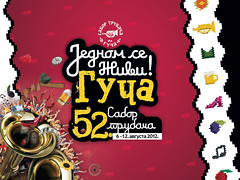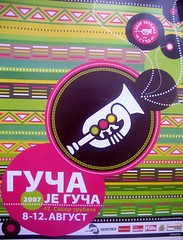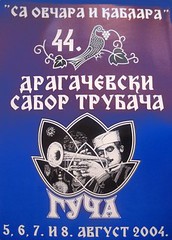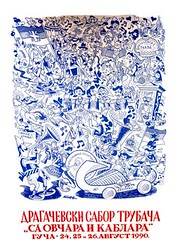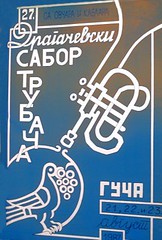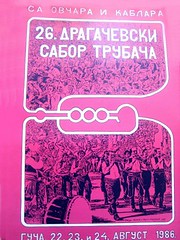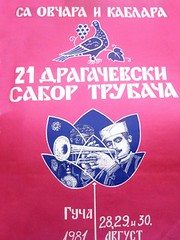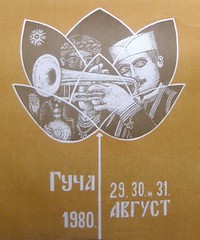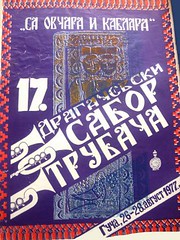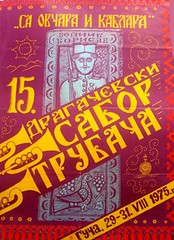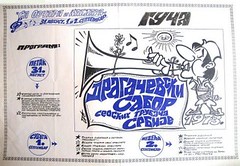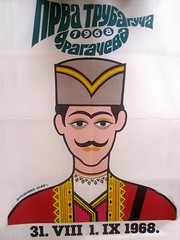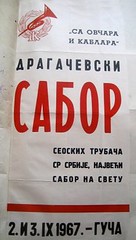.jpg)
Posts mit dem Label sabor guča werden angezeigt. Alle Posts anzeigen
Posts mit dem Label sabor guča werden angezeigt. Alle Posts anzeigen
Dejan Petrović, pobednik Guče i majstor trube
Dejan Lazarević: Uskoro će svetlost dana ugledati novi CD sa specifičnim balkanskim zvukom koji je Lazarević radio u saradnji sa popularnim čačanskim bendom (Prilog: http://www.citybox.rs/index.php?str=muzika&cd_id=341).
.jpg)
Dejan Petrović već spremio repertoar
- Nastupićemo verovatno u nešto modernijoj varijanti na ovogodišnjem Saboru trubača. Naravno, srpska tradicija je deo svakog našeg nastupa, ali ove godine ćemo koncert obogatiti novim numerama, veoma zanimljivim. Planirano goste, u svakom slučaju obećavamo odličnu zabavu i kvalitetan program - kaže Lazarević. On dodaje da bi ga radovalo da u Guču dođu zvučna imena poput filmske dive Džulije Roberts, pa ako se to obistini, Lazarević će kao i njegov kolega biti spreman.
Dejan Petrović u Vršcu Najmlađi i višestruki pobednik Sabora trubača u Guči i prva truba sveta Dejan Petrović održaće sa svojim Big bendom veliki koncert u hali “Milenijum” u Vršcu 10. marta. - Kao i sve dosadašnje, i ovaj koncert posvećujem svojoj ćerki Jovani, najvećoj radosti i najvećem pokretaču u životu. Mnoge sam želje ispunio, ostala je još jedna, a to je svetska karijera. Želim da autentičan zvuk srpske trube pronesem svetom - kaže Dejan Petrović.
S. M. - Imamo repertoar i za popularnu glumicu. Samo neka dođe, biće oduševljena - poručuje Lazarević. Treći Dejan - Jevđić, upotpuniće muzički nastup velikana trube. Najmlađi u svetu nagrada za izvođenje na limenim instrumentima Dejan Jevđić je sa orkestrom “Zao Taro lajt” prošle godine podigao Zlatnu trubu Sabora. - Radimo predano. Svakodnevno vežbamo za Guču, a mene posebno raduje činjenica da ću nastupati sa imenjacima Lazarevićem i Petrovićem.
Moramo za taj koncert da odaberemo najbolji repertoar i budemo posebno dobri. Nema sumnje, ljubiteljima trube ostaće u pamćenju planirana svirka jer nagrade najbolje govore o kvalitetu trubača - kaže Jevđić. Koncert trojice Dejana, trubačkih superstarova, novina je ove godine. Dosad su najbolji svirali na ponoćnom koncertu, a “Tri D” upriličen je kao poseban poklon organizatora ljubiteljima trube.
Izvor: http://www.blic.rs
Dejan Petrović, pobednik Guče i majstor trube
Dejan Lazarević: Uskoro će svetlost dana ugledati novi CD sa specifičnim balkanskim zvukom koji je Lazarević radio u saradnji sa popularnim čačanskim bendom (Prilog: http://www.citybox.rs/index.php?str=muzika&cd_id=341).
.jpg)
Dejan Petrović već spremio repertoar
- Nastupićemo verovatno u nešto modernijoj varijanti na ovogodišnjem Saboru trubača. Naravno, srpska tradicija je deo svakog našeg nastupa, ali ove godine ćemo koncert obogatiti novim numerama, veoma zanimljivim. Planirano goste, u svakom slučaju obećavamo odličnu zabavu i kvalitetan program - kaže Lazarević. On dodaje da bi ga radovalo da u Guču dođu zvučna imena poput filmske dive Džulije Roberts, pa ako se to obistini, Lazarević će kao i njegov kolega biti spreman.
Dejan Petrović u Vršcu Najmlađi i višestruki pobednik Sabora trubača u Guči i prva truba sveta Dejan Petrović održaće sa svojim Big bendom veliki koncert u hali “Milenijum” u Vršcu 10. marta. - Kao i sve dosadašnje, i ovaj koncert posvećujem svojoj ćerki Jovani, najvećoj radosti i najvećem pokretaču u životu. Mnoge sam želje ispunio, ostala je još jedna, a to je svetska karijera. Želim da autentičan zvuk srpske trube pronesem svetom - kaže Dejan Petrović.
S. M. - Imamo repertoar i za popularnu glumicu. Samo neka dođe, biće oduševljena - poručuje Lazarević. Treći Dejan - Jevđić, upotpuniće muzički nastup velikana trube. Najmlađi u svetu nagrada za izvođenje na limenim instrumentima Dejan Jevđić je sa orkestrom “Zao Taro lajt” prošle godine podigao Zlatnu trubu Sabora. - Radimo predano. Svakodnevno vežbamo za Guču, a mene posebno raduje činjenica da ću nastupati sa imenjacima Lazarevićem i Petrovićem.
Moramo za taj koncert da odaberemo najbolji repertoar i budemo posebno dobri. Nema sumnje, ljubiteljima trube ostaće u pamćenju planirana svirka jer nagrade najbolje govore o kvalitetu trubača - kaže Jevđić. Koncert trojice Dejana, trubačkih superstarova, novina je ove godine. Dosad su najbolji svirali na ponoćnom koncertu, a “Tri D” upriličen je kao poseban poklon organizatora ljubiteljima trube.
Izvor: http://www.blic.rs
Pečat Dragačeva - Zoran Hristić
.jpg) Ljubazno zamoljen da napišem nešto o Dragačevu, odnosno o Saboru trubača (pa zar to nije jedno te isto!), našao sam se u čudu, jer to je slično kao kada bi me neko zamolio da napišem ljubavno pismo! Međutim, ipak ima logike. Dragačevo, Guča, sabor, pesma i ritam moje su stare ljubavi.
Ljubazno zamoljen da napišem nešto o Dragačevu, odnosno o Saboru trubača (pa zar to nije jedno te isto!), našao sam se u čudu, jer to je slično kao kada bi me neko zamolio da napišem ljubavno pismo! Međutim, ipak ima logike. Dragačevo, Guča, sabor, pesma i ritam moje su stare ljubavi. Kada se piše o ljubavi, biraju se reči, dovoljno lepe da se zaboravi svakodnevica, da se utone u nešto nalik na san i izbegava se reč ''ali'', jer sreću ''saborišta'' ne sme ništa da pokvari. Čovek se, po prirodi stvari, vraća onome što voli...
Zaljubljenik Sabora ima tu sreću da to može da čini svake godine, da to jedva čeka svake godine, a da pri tome u slavlju i pravim salvama zvuka zaboravi da je još jednu godinu stariji. I tako svake godine čeka ga jedna umivena, nasmejana i trešteća Guča, koja ga slatko umori, promukne, ''budilicom'' razbija mamurluk, natera ga na radost i razmazi srećom.
Provodeći vreme po zagušljivim studijama za snimanje muzike, žvaćući muku svoga posla, u svome nemiru često se setim Guče i njenog zvuka od iskona. Tada shvatim koliko tome pripadam, odakle sam i gde ću biti. U retkim časovima prividnog mira i ne pokušavam da nađem zvuk iz Guče, on sam nadolazi kao obeležje jednog naroda. Sabor u Guči je pečat Dragačeva i prsten našeg venčanja sa trubom.
Truba u Dragačevu nikada ne svira ''krivo'', jer dostaojanstvo ljudi nameće pravila ponašanja zvuka, koji se tri dana rasplamsava do onog ''prometejskog trenutka'', kada nam se od veličanstvenosti zajedničkog sviranja ''Sa Ovčara i Kablara'' izmiče tle pod nogama, pali krv u venama i stiskaju pesnice u slavu naše ljubavi prema slobodi.
Shake it, Guča - Matija Bećković
 It is not habitual for the host to speak, except if hosting the Trumpeters Festival in Guča, where every guest becomes the host from the moment when he enters the world capital of trumpet. As the host among hosts, I asked how long should I speak. They answered like true hosts do – tell us how long you would like to speak. Well, then, with permission – listen and hear!
It is not habitual for the host to speak, except if hosting the Trumpeters Festival in Guča, where every guest becomes the host from the moment when he enters the world capital of trumpet. As the host among hosts, I asked how long should I speak. They answered like true hosts do – tell us how long you would like to speak. Well, then, with permission – listen and hear!The trumpet has been in use by people and angels since ever, and never and nowhere without good reason. Here, in Guča, the trumpeters are among the first ones to take into their hands the trumpets, and they do so with one reason more. They say that the first trumpet descended to Guča looking for a place from where it could be heard the farthest. All her sisters followed her in flocks and jointly thundered into the chest of Serbia.
The call of the trumpet made all that sounds and tunes in, all the quivers and joining quivers on that loud side with which all the sides are linked, all the languages, the skies and the earth, to start roaring, storming and weeping.
The people and those musicians without scores and those with musical notations in their soles swarm to follow the sound. And the sound which makes you tremble, is the sound of the mother whose son you are – so says the poet. So it happened that since the Festival in Žiča we perhaps did not have a more joyful festival than the Festival in Guča! Life seeks an exit, and the sound seeks its rights.
The walls destroyed by the trumpets of Jericho, are destroyed also by the trumpets of Dragačevo, and this has been going on for forty two years now. In some places they call it Woodstock, in others Mariachi, or Band-aid, or Exit, but everybody knows that Guča is the exit and that the original sounds better.
What many intellectuals do not know, Serbian peasants did not forget. It is better to blow a trumpet, than to sniff glue! Therefore, we hardly do have something more urban and more superior than the Trumpeters Festival in Guča. Obviously, the world Festival in Guča is Serbian contribution to globalization. Namely, if we would join the European Community without our tunes and colors, without our name and memories, how would they know who came to them and what they brought with them?
From the old to the new era, from the goose-feather pen to the computers, from calls across across the hills to the mobile phone and e-mail – everything that was ever created has still been in the process of transformation and creation. And this is not a Festival, but rather a volcano of health and beauty, which was activated from the heart of Serbia. And new, young volcanoes always become active where the old ones were active, too.
There is nothing we did not use to make music with: the leaf, the comb, the glass, the hair, the nails, the fingers, the horns, the belt, the stones, the eye-lashes, the mustache. There is no tree from which we did not try to make a trumpet. And there are no two leaves that did not differ, nor two stones which did not make echoes in a different way. And everything that we see on the Earth, are instruments of the big and glorious people's philharmonic orchestra. And to those trumpets which are today in Guča responding to the sun, this is what we must say: I know you, trumpet, when you used to be a willow tree!
The self-willed voices, the stubbornness of accents, the individuality of tunes – they will never cease to live and move human hearts. The biggest achievements of mind and hand which belong to the general spiritual property of mankind, all the immortal things which Earth gave to the skies, it related to the people and multiplied with the people!
Poets compared our embroideries with the wistfulness of Bach's and Schuman's solo violins. We know that embroidery, national costumes, folk dance, rituals, habit are also symbols with many meanings. But hundreds of thousands of participants in the Festival in Guča come to enjoy, dance and sing, and do not listen to interpretations!
Modern man has reached far, but it seems as if he noticed before reaching the aim that he did not take his heart and his soul with him.
And now, without these two, he does not care about the entire world. And this is where the deeper substance of the Festival in Guča is hidden. Not only by returning to oneself, but returning to joy and to the sense of living.
The State is what its music is – said Confucius 500 years B.C. If we only could say this for Serbia – how well off we would be! It is unbelievable that the State can be second-hand, and music original and authentic.
Throwing garbage to the wells is one of the biggest disasters of our spiritual ecology. Famous is the case of the shepherdess which happened right here, sixty years ago. She allegedly started suddenly to call somebody from the Ovčar and Kablar mountains whose name nobody has ever heard before and to ask him nothing else but when he will be coming to Užice, without asking why he should be in Užice and whom he has there. This is how one of the most irrational creations emerged, which was sung for decades with most disastrous consequences. And nobody was wondering about those who forged this song, they were rather persecuting those who memorized the original.
Thanks God, everything ended well and at the 42nd Trumpeters Festival in Guča we heard the original version as if such wonder had never existed! Hence: Serbian Principle, accept us among the Serb people! Welcome and come with luck – and leave with even more luck!
Shake it, maple!
Matija BEĆKOVIĆ, poet and novelist Letter of the host at the opening of 42nd FESTIVAL 2002nd
Grunula je truba, Branko V. Radičević
.jpg) Sve se izgleda menja. Sabor ostaje isti. Kao element. Zemlja. Vazduh. Voda. Pečenje. Lebac i slanina. Beli lukac. Kolovođa i kec. Prvi i poslednji u kolu. Sabor je čudo. I to čudo nad čudima. Trebalo je, pre trideset i pet godina, promarširati ulicama Guče. U anteriji. Sa šajkačom na glavi. U prisustvu vlasti. U pratnji trubača.
Sve se izgleda menja. Sabor ostaje isti. Kao element. Zemlja. Vazduh. Voda. Pečenje. Lebac i slanina. Beli lukac. Kolovođa i kec. Prvi i poslednji u kolu. Sabor je čudo. I to čudo nad čudima. Trebalo je, pre trideset i pet godina, promarširati ulicama Guče. U anteriji. Sa šajkačom na glavi. U prisustvu vlasti. U pratnji trubača.To je čudo. Taj pohod koji traje. Koji ne prestaje. Od Sabora do Sabora. Od grada do grada. U kasno leto. Pred jesen. Dumbara bubanj. Igra kolo. Ali, molim vas, zamislite: kako je to bilo pre trideset i pet godina. U prikradici. U prekorici. Kao inačica. Tek će narasti inat. Tek će se zainatiti pravi inat. U sveopštoj sumnji.
Prikradalo se. I pripremalo veliko kolo. U prikradici. Naizgled naivno i nevešto. Trebalo je imati hrabrosti. I odoleti pokudicama. Šta će vam to tu? I zašto će vam baš tu? I šta će tu Dragačevo? I zar se to sme u Dragačevu? I šta će drugi reći? I kako će se drugi ponašati? I ko će za to odgovarati? I šta ako se to u nešto neprilično izrodi? Opasno je! Nije vreme! Zašto baš trube? I šta će tu trube? Pa to podseća na ratove! I kakvi su to bili ratovi! Ima ratova i ratova. Osvajačkih, napadačkih, tlačiteljskih, nepravedenih, opakih i zlovremenih.
Šta će tu trube ? Na šta nas podsećaju? Na nekakva knjaževstva i kraljevstva?
Nije Srbin izmislio trubu. Šta će truba u kolu? Ima ona preča posla. Zna se njeno mesto. Ispraća u ratove. I maršira s vojskama. Jedan, dva. Pod komandom. Jedan, dva. Ne može u šest koraka.
I grunula je. U Dragačevu. Kao izazov. I prkos. Prisetila. Podsetila. Promladila. Dahnula vedrinom. I nadom. Jer narod igra. Ima nade. Jer narod igra. Dobro je kad narod igra. Zasvadbariće jesen. Rađaće se deca. Oživeće njive i livade. Biće leba i slanine. Zaratariće zemlja. Neće zaratovati. Ona će zaratariti. Jer bog Perun, vrhovni srpski bog, nije bog ratova, već berićeta, bog plodnosti. On opominje gromovima i munjama. On upravlja zemljom i nebesima. I šalje kišu na žednu zemlju. Oplođuje. Preporađa. Omlađuje. Stvara. Daruje.
Trebalo je lukavo, polako, strpljivo, uz neophodne dodvorice i nepotrebne pristanke, očuvati saborovinu, koja je postala dadž, napajala ljude verom i nadom da još ima zdravlja i da nije sve prošlo i da će se živeti i ploditi.
Zaigralo je veliko saborsko kolo. I porodio se veliki, opštenarodni inat. Truba se pretvorila u čudo. Oslušnite je. Drma. Čućete što nikad niste čuli. Čućete ako ste posustali. Čućete ako ste posumljali. Ima spasa. Ima nade. Čućete ako ste se odrodili. Čućete ako se još niste porodili. Čućete ako ste se zaplodili.
Moj glas je slab. Nemam snage da nadvičem trubu. Sve što sam govorim, kazaće vam truba. Ona neprestano samo o tome trubi. Treba je čuti, slušati i razumeti. Ona umesto nas progovara. Jednog dana, ko zna kada, došla je među nas iz dalekog belog sveta. I progovorila je našim glasom. Baš kao da je svirala. Kao da se usvirala. I uguslila. Videli smo je na slikama posvećenim Božijim prostorima. Anđeli navešćuju dolazak. Strašnog suda. Ona se potpuno pripitomila u Dragačevu. Ne poziva na juriš. Neće u rat. Ne navešćuje propast sveta. Dolazak Strašnog suda. Započinje kolo. Svetkuje. I razastire radost. I zato je dobrodošla. Kao preporoditeljka. Na radost. I veselje.
Čudo zvano Guča, Momo KAPOR
.jpg) Ko je mogao i da pomisli da će zov trube uspeti da okupi, ni manje ni više, šesto hiljada ljudi i da će na pustim poljanama Guče nići, kao u kakvom ratnom pohodu, polje šatora? A svi su zaboravili, niko ni da pomene, da je čitavu tu priču pre četrdeset devet goina, 1960. godine, započeo jedan pesnik, Branko V. Radičević, zvani Mačista, koji je proslavio Srbiju, a posebno Čačak, odakle je rodom, svojim pesmama i poemama. Niko da se seti Mača, koji je sa nekolicinom prijatelja sakupio tri-četiri sirota duvačka orkestra koji su se potucali po Srbiji po svadbama i sahranama, više gladni nego siti, i da ih je doveo u portu ispred crkve Svetih arhangela Mihaila i Gavrila u Guči da tu sviraju ceo letnji dan do podne, a onda, bogami, i uveče, i sve tako, puna tri dana.
Ko je mogao i da pomisli da će zov trube uspeti da okupi, ni manje ni više, šesto hiljada ljudi i da će na pustim poljanama Guče nići, kao u kakvom ratnom pohodu, polje šatora? A svi su zaboravili, niko ni da pomene, da je čitavu tu priču pre četrdeset devet goina, 1960. godine, započeo jedan pesnik, Branko V. Radičević, zvani Mačista, koji je proslavio Srbiju, a posebno Čačak, odakle je rodom, svojim pesmama i poemama. Niko da se seti Mača, koji je sa nekolicinom prijatelja sakupio tri-četiri sirota duvačka orkestra koji su se potucali po Srbiji po svadbama i sahranama, više gladni nego siti, i da ih je doveo u portu ispred crkve Svetih arhangela Mihaila i Gavrila u Guči da tu sviraju ceo letnji dan do podne, a onda, bogami, i uveče, i sve tako, puna tri dana.Vraćajući se u Beograd, Mač je natovario u kola i teški krajputaš iz okoline Čačka, prvi koji je ikada videla prestonica, uvevši tako u modu staru tradicionalnu skulpturu, i to obojenu, dok su se intelektualci divili rupama Engleza Henrija Mura. E, pa lepo bi bilo da je bilo ko od zvaničnika makar i pomenuo Mačistu, Branka V. Radičevića, ali Srbija je to: ona lako zaboravlja. Uostalom, pokojni Mačista ima vremena da čeka da ga pomenu.
Sva muka i bes, sva lepota i tuga, sva radost i muzika, koje se sakupe za godinu dana u Srbiji, prve nedelje avgusta šiknu u nebo kroz blistava grla truba na Saboru u Guči. To je događaj na koji seljačka Srbija nestrpljivo čeka punih godinu dana. Tada Guča, varošica u brdima, postaje svetska prestonica trube.
Ne zna se pouzdano kada su se i kako trube primile u Srbiji, koja je odvajkada poznavala uglavnom gusle, pastirske svirale, frule i dvojnice, ali je to verovatno bilo posle srpsko-turskih ratova potkraj devetnaestog veka, kada su se četni i pukovski trubači vratili u svoja sela, donevši sa sobom olupane, ulubljene i izubijane, a često i kuršumima probijene trube, kojima su, do tada, pozivali na juriše i svirali povečerja. Ratovi koji su usledili početkom novog veka znatno su povećavali, sem mrtvih, i broj truba. Zbog toga je u njihovom tonu još uvek najizrazitiji ratnički zvuk, poklič na pobedu ili smrt – tanki, mesingani lim, naliven melanholičnom mrenom povečerja.
Donosili su ih kao dragocenosti, pažljivo uvijene u krpe i futrole, sašivene od uvoštenih šatorskih krila, u svoja zabita sela. Odmotane i pažljivo izglancane blesnule bi, usred bode siromašnih izbi, sjajem zlatnog roga. Čuvali su ih brižljivo i negovali, zasviravši katkad u sutonu kolce ili posmrtni marš, sve dok ne postadoše pravi virtuozi, ravni, ako ne i bolji, od meksičkih marijačija. Svojim instrumentima postizali su i najviše, gotovo nemoguće tonove, ali su bili u stanju i da nežno, trubama, bekrijama šapuću u uvo uspavanke. I kao što je šljiva madžarka u ovom delu Srbije pronašla najpogodnije tlo za svoje sokove, isto tako se primila i truba, do tada nepoznata srpskim muzičarima. Pokazalo se da se nijednim muzičkim instrumentom, čak ni violinom, za koju su bili majstori Cigani, ne može bolje izraziti suština bića ovog naroda, ponekad kroz krik, često kroz suze, jecaje ili promukli smeh, a najčešće kroz obesne taktove narodnih kola, punih razuzdane radosti.
I sada su se, sa svih strana Srbije, sjatili svi u Guču. I oni koji su tek nedavno prvi put dunuli u pisak, i oni što su živeli od sviranja po svadbama, sahranama, vašarima i zabitim krčmama. Bilo je među njima svakojakih; onih u seljačkim gunjevima i opancima-šiljkanima, sa šajkačama na glavama, i drugih, što su već stekli ime, pa se odenuli u svilene košulje jarkih boja i širokih rukava, prsluke i lakovane cipele. Došli su tu odršani orkestri bez sluha i imalo muzikalnosti, uvežbani ansambli, koji su već nastupali na televiziji i igrali po filmovima, ciganski orkestri sa rumunske i bugarske granice i družine sa imenima nagrada ispisanim na bubnjevima pozlaćenih činela – čak i ansambl američkih marinaca! u Guču su se sjatilii rojevi domaćih i stranih filmskih i televizijskih ekipa da zabeleže kamerama još jedan potpuno nepredvidljivi uzlet srpskog duha. Već prve noći, podanici prestonice trube, zaplitali su jezicima i provlačili se kroz stolove pod šatrama u osmicama, opijeni raskošnim zvukom i pićem što se nemilice točilo na svakom koraku. Najbrojniji među njima došli su iz obližnjih gradova i Beograda, a nije bilo malo ni onih što su stigli čak iz Evrope i Amerike, da nedelju dana traže i pronalaze svoje zaboravljene korene. Samo na ovom mestu mogle su da se susretnu leptir-mašne sa šajkačama, mlade lepotice sa slavnim, pijanim starcima, dame, odevene po poslednjoj pariskoj modi, sa zabrađenim seljankama; pod šatrama koje su bazdile po rakiji, pečenom mesu i duvanskom dimu što je naprosto kuljao iz njih. Svaka šatra postala je improvizovana gostionica sa rasparenim stolicama i sastavljenim stolovima prekrivenim čaršavima, u kojoj su se smenjivala i nadmetala, naizmenično, po dva-tri orkestra duvača. Pred jutro, iskolačenih očiju, okrenuli bi svoje trube jedni naspram drugih, poput tromblonskih bacača zvuka, izduvavajući svu svoju nagomilanu snagu i bes kroz njih, nadmećući se ko će koga da nadjača i otera sa poprišta. Lepotice su se pele na stolove i igrale po njima (zvali su ih stolovače), a muškarci padali u dert, razvezivali kravate i opuštali kaiševe ispod nabreklih trbuha. Ništa se, naime, ne slaže i ne prožima tako dobro kao šljivovica iz tog kraja i svirka duvača-Dragačevaca.
Oko šatri su se okretali danonoćno ražnjevi sa prasićima i jaganjcima a na nekoliko mesta i teški volovi, sa kojih su vešti majstori noževima odsecali ispečeni sloj, i dok se pekao novi, prodavali još vrele režnjeve volujskog mesa u rasečenim lepinjama.
Što se tiče ovogodišnje Guče, zapanjile su me dve stvari: prva, da nije bilo nijednog slučaja svinjskog gripa, koji hara planetom, a to iz dva razloga – najpre, zbog toga što su gosti pojeli svu raspoloživu svinjetinu, tako da grip nije stigao da se zapati u njoj, a i to je najzad dokazano, da bacili gripa umiru na metar i sedamdeset pet centimetara udaljenosti od onoga koji je popio tri litra vina ili gajbu piva. Tako je slučajno i pronađen najbolji serum protiv gripa. Druga stvar koja me zapanjuje, po ko zna koji put, jesu pijani Slovenci, koji dokazuju da nema šta da tražimo u Evropskoj uniji, jer da je tamo dobro, ne bi dolazili kod nas u Guču da se provedu pod sloganom ''Samo jednom se živi!'' Kako im je tamo, najbolje se vidi iz načina na koji piju: oni se opijaju mračno i depresivno, bilo čim što im dođe do ruku, samo da pobegnu od načina života kojim žive.
Ono što je potpuno nelogično u Guči kuva se u velikim zemljanim loncima, i zove se svadbarski kupus. Kiseo kupus u avgustu, to me zaprepašćuje. Da li je to onaj poplesnivili kupus, preostao od zimus, ili su ga zakiselili na brzu ruku, ostaće zauvek tajna. Zaista ga je perverzno jesti usred leta.
Primetio sam još da Guča, i pored svoje popularnosti, polako ali sigurno gubi svoju izvornu dušu, približavajući se američkom Vudstoku ili novosadskom Egzitu. Njena buduća propast počela je prisustvom u orkestrima saksofona, koji je do tada bio nepoznat instrument u srpskoj narodnoj muzici, a nastavlja se sa sve prisutnijim klavijaturama. Još samo nedostaju orgulje i harfistkinja sa šajkačom, pa da stvar bude potpuna. Još nešto: u repertoar se sve više uvlače belosvetski šlageri od Maj veja do Kondorovog leta – kao , možemo i to. Za iduću godinu Guča je najavila takmičenje za prvu trubu sveta. Šteta što su umrli Dizi Gilespi i Majls Dejvis – oni bi sigurno došli da se takmiče sa Salijevićima.
Kao što je ono prase pitalo, ima li života posle Đurđevdana, tako se i mi pitamo, ima li ga posle Guče?
Momo KAPOR, književnik i slikar Nin, Beograd, 20. avgust 2009.Čudo zvano Guča, Momo KAPOR
.jpg) Ko je mogao i da pomisli da će zov trube uspeti da okupi, ni manje ni više, šesto hiljada ljudi i da će na pustim poljanama Guče nići, kao u kakvom ratnom pohodu, polje šatora? A svi su zaboravili, niko ni da pomene, da je čitavu tu priču pre četrdeset devet goina, 1960. godine, započeo jedan pesnik, Branko V. Radičević, zvani Mačista, koji je proslavio Srbiju, a posebno Čačak, odakle je rodom, svojim pesmama i poemama. Niko da se seti Mača, koji je sa nekolicinom prijatelja sakupio tri-četiri sirota duvačka orkestra koji su se potucali po Srbiji po svadbama i sahranama, više gladni nego siti, i da ih je doveo u portu ispred crkve Svetih arhangela Mihaila i Gavrila u Guči da tu sviraju ceo letnji dan do podne, a onda, bogami, i uveče, i sve tako, puna tri dana.
Ko je mogao i da pomisli da će zov trube uspeti da okupi, ni manje ni više, šesto hiljada ljudi i da će na pustim poljanama Guče nići, kao u kakvom ratnom pohodu, polje šatora? A svi su zaboravili, niko ni da pomene, da je čitavu tu priču pre četrdeset devet goina, 1960. godine, započeo jedan pesnik, Branko V. Radičević, zvani Mačista, koji je proslavio Srbiju, a posebno Čačak, odakle je rodom, svojim pesmama i poemama. Niko da se seti Mača, koji je sa nekolicinom prijatelja sakupio tri-četiri sirota duvačka orkestra koji su se potucali po Srbiji po svadbama i sahranama, više gladni nego siti, i da ih je doveo u portu ispred crkve Svetih arhangela Mihaila i Gavrila u Guči da tu sviraju ceo letnji dan do podne, a onda, bogami, i uveče, i sve tako, puna tri dana.Vraćajući se u Beograd, Mač je natovario u kola i teški krajputaš iz okoline Čačka, prvi koji je ikada videla prestonica, uvevši tako u modu staru tradicionalnu skulpturu, i to obojenu, dok su se intelektualci divili rupama Engleza Henrija Mura. E, pa lepo bi bilo da je bilo ko od zvaničnika makar i pomenuo Mačistu, Branka V. Radičevića, ali Srbija je to: ona lako zaboravlja. Uostalom, pokojni Mačista ima vremena da čeka da ga pomenu.
Sva muka i bes, sva lepota i tuga, sva radost i muzika, koje se sakupe za godinu dana u Srbiji, prve nedelje avgusta šiknu u nebo kroz blistava grla truba na Saboru u Guči. To je događaj na koji seljačka Srbija nestrpljivo čeka punih godinu dana. Tada Guča, varošica u brdima, postaje svetska prestonica trube.
Ne zna se pouzdano kada su se i kako trube primile u Srbiji, koja je odvajkada poznavala uglavnom gusle, pastirske svirale, frule i dvojnice, ali je to verovatno bilo posle srpsko-turskih ratova potkraj devetnaestog veka, kada su se četni i pukovski trubači vratili u svoja sela, donevši sa sobom olupane, ulubljene i izubijane, a često i kuršumima probijene trube, kojima su, do tada, pozivali na juriše i svirali povečerja. Ratovi koji su usledili početkom novog veka znatno su povećavali, sem mrtvih, i broj truba. Zbog toga je u njihovom tonu još uvek najizrazitiji ratnički zvuk, poklič na pobedu ili smrt – tanki, mesingani lim, naliven melanholičnom mrenom povečerja.
Donosili su ih kao dragocenosti, pažljivo uvijene u krpe i futrole, sašivene od uvoštenih šatorskih krila, u svoja zabita sela. Odmotane i pažljivo izglancane blesnule bi, usred bode siromašnih izbi, sjajem zlatnog roga. Čuvali su ih brižljivo i negovali, zasviravši katkad u sutonu kolce ili posmrtni marš, sve dok ne postadoše pravi virtuozi, ravni, ako ne i bolji, od meksičkih marijačija. Svojim instrumentima postizali su i najviše, gotovo nemoguće tonove, ali su bili u stanju i da nežno, trubama, bekrijama šapuću u uvo uspavanke. I kao što je šljiva madžarka u ovom delu Srbije pronašla najpogodnije tlo za svoje sokove, isto tako se primila i truba, do tada nepoznata srpskim muzičarima. Pokazalo se da se nijednim muzičkim instrumentom, čak ni violinom, za koju su bili majstori Cigani, ne može bolje izraziti suština bića ovog naroda, ponekad kroz krik, često kroz suze, jecaje ili promukli smeh, a najčešće kroz obesne taktove narodnih kola, punih razuzdane radosti.
I sada su se, sa svih strana Srbije, sjatili svi u Guču. I oni koji su tek nedavno prvi put dunuli u pisak, i oni što su živeli od sviranja po svadbama, sahranama, vašarima i zabitim krčmama. Bilo je među njima svakojakih; onih u seljačkim gunjevima i opancima-šiljkanima, sa šajkačama na glavama, i drugih, što su već stekli ime, pa se odenuli u svilene košulje jarkih boja i širokih rukava, prsluke i lakovane cipele. Došli su tu odršani orkestri bez sluha i imalo muzikalnosti, uvežbani ansambli, koji su već nastupali na televiziji i igrali po filmovima, ciganski orkestri sa rumunske i bugarske granice i družine sa imenima nagrada ispisanim na bubnjevima pozlaćenih činela – čak i ansambl američkih marinaca! u Guču su se sjatilii rojevi domaćih i stranih filmskih i televizijskih ekipa da zabeleže kamerama još jedan potpuno nepredvidljivi uzlet srpskog duha. Već prve noći, podanici prestonice trube, zaplitali su jezicima i provlačili se kroz stolove pod šatrama u osmicama, opijeni raskošnim zvukom i pićem što se nemilice točilo na svakom koraku. Najbrojniji među njima došli su iz obližnjih gradova i Beograda, a nije bilo malo ni onih što su stigli čak iz Evrope i Amerike, da nedelju dana traže i pronalaze svoje zaboravljene korene. Samo na ovom mestu mogle su da se susretnu leptir-mašne sa šajkačama, mlade lepotice sa slavnim, pijanim starcima, dame, odevene po poslednjoj pariskoj modi, sa zabrađenim seljankama; pod šatrama koje su bazdile po rakiji, pečenom mesu i duvanskom dimu što je naprosto kuljao iz njih. Svaka šatra postala je improvizovana gostionica sa rasparenim stolicama i sastavljenim stolovima prekrivenim čaršavima, u kojoj su se smenjivala i nadmetala, naizmenično, po dva-tri orkestra duvača. Pred jutro, iskolačenih očiju, okrenuli bi svoje trube jedni naspram drugih, poput tromblonskih bacača zvuka, izduvavajući svu svoju nagomilanu snagu i bes kroz njih, nadmećući se ko će koga da nadjača i otera sa poprišta. Lepotice su se pele na stolove i igrale po njima (zvali su ih stolovače), a muškarci padali u dert, razvezivali kravate i opuštali kaiševe ispod nabreklih trbuha. Ništa se, naime, ne slaže i ne prožima tako dobro kao šljivovica iz tog kraja i svirka duvača-Dragačevaca.
Oko šatri su se okretali danonoćno ražnjevi sa prasićima i jaganjcima a na nekoliko mesta i teški volovi, sa kojih su vešti majstori noževima odsecali ispečeni sloj, i dok se pekao novi, prodavali još vrele režnjeve volujskog mesa u rasečenim lepinjama.
Što se tiče ovogodišnje Guče, zapanjile su me dve stvari: prva, da nije bilo nijednog slučaja svinjskog gripa, koji hara planetom, a to iz dva razloga – najpre, zbog toga što su gosti pojeli svu raspoloživu svinjetinu, tako da grip nije stigao da se zapati u njoj, a i to je najzad dokazano, da bacili gripa umiru na metar i sedamdeset pet centimetara udaljenosti od onoga koji je popio tri litra vina ili gajbu piva. Tako je slučajno i pronađen najbolji serum protiv gripa. Druga stvar koja me zapanjuje, po ko zna koji put, jesu pijani Slovenci, koji dokazuju da nema šta da tražimo u Evropskoj uniji, jer da je tamo dobro, ne bi dolazili kod nas u Guču da se provedu pod sloganom ''Samo jednom se živi!'' Kako im je tamo, najbolje se vidi iz načina na koji piju: oni se opijaju mračno i depresivno, bilo čim što im dođe do ruku, samo da pobegnu od načina života kojim žive.
Ono što je potpuno nelogično u Guči kuva se u velikim zemljanim loncima, i zove se svadbarski kupus. Kiseo kupus u avgustu, to me zaprepašćuje. Da li je to onaj poplesnivili kupus, preostao od zimus, ili su ga zakiselili na brzu ruku, ostaće zauvek tajna. Zaista ga je perverzno jesti usred leta.
Primetio sam još da Guča, i pored svoje popularnosti, polako ali sigurno gubi svoju izvornu dušu, približavajući se američkom Vudstoku ili novosadskom Egzitu. Njena buduća propast počela je prisustvom u orkestrima saksofona, koji je do tada bio nepoznat instrument u srpskoj narodnoj muzici, a nastavlja se sa sve prisutnijim klavijaturama. Još samo nedostaju orgulje i harfistkinja sa šajkačom, pa da stvar bude potpuna. Još nešto: u repertoar se sve više uvlače belosvetski šlageri od Maj veja do Kondorovog leta – kao , možemo i to. Za iduću godinu Guča je najavila takmičenje za prvu trubu sveta. Šteta što su umrli Dizi Gilespi i Majls Dejvis – oni bi sigurno došli da se takmiče sa Salijevićima.
Kao što je ono prase pitalo, ima li života posle Đurđevdana, tako se i mi pitamo, ima li ga posle Guče?
Momo KAPOR, književnik i slikar Nin, Beograd, 20. avgust 2009.Day trip to Ovčarsko Kablar canyon
Day trip to Ovcarsko Kablar canyon - Trumpet Festival It is located in central Serbia, where the Morava river between the mountains and Shepherd Kablar gorge cuts an imposing shadow scale in forest on the banks of the river, the small plateau close to the rocks and hiding the 11 medieval monasteries, the unique place where there are time when they occur. On the left side of the Western Morava are the Annunciation, Ilinje, Savinja Nikolje, Assumption and Jovanje, and on the right the Temple, Trinity, Transfiguration, Assumption and the Presentation.
Day trip to Ovčarsko Kablar canyon
Day trip to Ovcarsko Kablar canyon - Trumpet Festival It is located in central Serbia, where the Morava river between the mountains and Shepherd Kablar gorge cuts an imposing shadow scale in forest on the banks of the river, the small plateau close to the rocks and hiding the 11 medieval monasteries, the unique place where there are time when they occur. On the left side of the Western Morava are the Annunciation, Ilinje, Savinja Nikolje, Assumption and Jovanje, and on the right the Temple, Trinity, Transfiguration, Assumption and the Presentation.
Serbian History of Trumpet Tradition
Dragačevo, which used to be a rural region, experienced strong economic and general educational and cultural development after 1950, and mostly in the first decade of the 21st century, first of all thanks to the Trumpeters Festival.
The capital of modern trumpeting - Guča, is relatively small, and the trumpet was first played as far ago as 1831. Before nearly two centuries Miloš Obrenović ordered the establishment of a "Principle's Serbian band" in Kragujevac, and that the first brass band be led by Josip Šlezinger (1794-1870), a man from Sombor, who in those times was the first musically literate expert in Serbia. "Oberlautar" Mustafa, a man who played the violin and "zurle" (zurna), was until then amusing the Serb ruler and his entourage "and was amusing also even foreigners who did not have much understanding for Turkish music". Immediately upon his arrival in Kragujevac he started to organize the band. Since he lacked in skilled musicians, he asked the Principle to arrange that young man from among the population be found, who have talent and will to do this job. Miloš promptly ordered that each county delegates five young men. And, so it started. Although it did not always run smoothly, they learned to play the new "golden" instruments, by playing the round-dances and songs which they knew and were familiar with them, but learning also everything that maestro J. Šlezinger was teaching them in the then Serbian capital Kragujevac.
Almost two centuries passed by, there were many outstanding military brass bands and band leaders from the regiments and divisions. However, only in the mid 19th century were the foreign musical and cultural influence getting stronger; they can be identified at the beginning of the new era in the folk music of Dragačevo and were particularly strong in regard to trumpet music and homophonic multi-part singing , i.e. in singing "na bas". How the brass bands were emerging we heard from spontaneous statements of modern Dragačevo musicians. It is known in Dljina that their oldest trumpeter "was a guy named Ćebić who was playing before World War I… And he himself inherited it from the past times. "In Goračići the first orchestra was founded by the Davidović brothers from Dragačica "probably sometimes about the times of World War I, and this band included only four musicians". Also, the story goes that "in Rti the band leader and first trumpet was Milisav Kostić–Tralja, and his today's heirs are trumpeters playing in the Srećko Obradović orchestra". And so we come also to the trumpeter Desimir Perišić from Goračići and the winning orchestra at the First Festival in Guča in 1961.
The songs are usually based of two-bar motives and melodies, mainly of two part structure consisting of 4 to 5 tones.
The vigorous folk round-dances from the western regions are characterized by occasional pauses of the leading trumpets, with the basses taking over the leading tune of the leading trumpets, highlighting the basic harmonies. Also, we will notice that southern folk dances are usually characterized by oriental music, in the so-called "aksak" rhythm. This is especially emphasized with the "performance" of the drummer, who expertly combines larger "čukan" (right hand) strokes with those of the thinner stick (left hand, on the edge of the drum, skillfully stressing the changes of double and triple meter in the specific rhythmical formulas and combinations (8/8; 7/8; 9/8 etc.), especially in the characteristic dances – songs called "chochek". Then, spontaneously and ravishingly, genuinely enjoying in the music, dance only those who truly know how to do it. In the eastern region a big number of folk dances of the "Batrna" (ancient dance) type and "Stara Vlajna", i.e. "Timočka Rumenka" or "Svrljiški laskavac", are preserving the genetic features of the Vallah or Serb Hora dancing, when the dancers are crossing their hands and holding each other by the belt. And all Serbian songs and dances have up to five tones, while Vallah melodies are more diversified and with an occasional alternation of the slow parts with the usually faster refrain. Singing with trumpet accompaniment is gaining in popularity nowadays here with us. Like the first folk trumpeters from the times of Miloš, contemporary ones are also mainly autodidacts having keen hearing, and are playing a huge repertoire of songs and dances by heart, and by the ear, improvising their interpretation spontaneously and from their soles and hearts. With the first orchestras, their members evolved as musicians and their number was invreasing. At the beginning the orchestras had five musicians, and the contemporary orchestras usually have up to ten musicians (three to four ''B'' trumpets, three bass flugelhorns, one bass trumpet – helicon or euphonium, and, finally, snare drum and large drum with cymbals. Three regions clearly identified themselves by the style of their music, and are today three famous centers with the best trumpeters in Serbia today. Although the trumpet is not as deeply rooted in our people like the vocal music tradition, the fact is that those active in the field of culture have four decades ago broke the ground for trumpet music in tiny Guča. Since then, like awakening from a dream, trumpet music grew very quickly in those areas of western, eastern and southern Serbia in which the trumpet seed probably had already been thrown and did exist, and it also woke up during so many decades in the center of Šumadija, where its seed was for the first time thrown in the far away year 1831.
The capital of modern trumpeting - Guča, is relatively small, and the trumpet was first played as far ago as 1831. Before nearly two centuries Miloš Obrenović ordered the establishment of a "Principle's Serbian band" in Kragujevac, and that the first brass band be led by Josip Šlezinger (1794-1870), a man from Sombor, who in those times was the first musically literate expert in Serbia. "Oberlautar" Mustafa, a man who played the violin and "zurle" (zurna), was until then amusing the Serb ruler and his entourage "and was amusing also even foreigners who did not have much understanding for Turkish music". Immediately upon his arrival in Kragujevac he started to organize the band. Since he lacked in skilled musicians, he asked the Principle to arrange that young man from among the population be found, who have talent and will to do this job. Miloš promptly ordered that each county delegates five young men. And, so it started. Although it did not always run smoothly, they learned to play the new "golden" instruments, by playing the round-dances and songs which they knew and were familiar with them, but learning also everything that maestro J. Šlezinger was teaching them in the then Serbian capital Kragujevac.
Almost two centuries passed by, there were many outstanding military brass bands and band leaders from the regiments and divisions. However, only in the mid 19th century were the foreign musical and cultural influence getting stronger; they can be identified at the beginning of the new era in the folk music of Dragačevo and were particularly strong in regard to trumpet music and homophonic multi-part singing , i.e. in singing "na bas". How the brass bands were emerging we heard from spontaneous statements of modern Dragačevo musicians. It is known in Dljina that their oldest trumpeter "was a guy named Ćebić who was playing before World War I… And he himself inherited it from the past times. "In Goračići the first orchestra was founded by the Davidović brothers from Dragačica "probably sometimes about the times of World War I, and this band included only four musicians". Also, the story goes that "in Rti the band leader and first trumpet was Milisav Kostić–Tralja, and his today's heirs are trumpeters playing in the Srećko Obradović orchestra". And so we come also to the trumpeter Desimir Perišić from Goračići and the winning orchestra at the First Festival in Guča in 1961.
The songs are usually based of two-bar motives and melodies, mainly of two part structure consisting of 4 to 5 tones.
The vigorous folk round-dances from the western regions are characterized by occasional pauses of the leading trumpets, with the basses taking over the leading tune of the leading trumpets, highlighting the basic harmonies. Also, we will notice that southern folk dances are usually characterized by oriental music, in the so-called "aksak" rhythm. This is especially emphasized with the "performance" of the drummer, who expertly combines larger "čukan" (right hand) strokes with those of the thinner stick (left hand, on the edge of the drum, skillfully stressing the changes of double and triple meter in the specific rhythmical formulas and combinations (8/8; 7/8; 9/8 etc.), especially in the characteristic dances – songs called "chochek". Then, spontaneously and ravishingly, genuinely enjoying in the music, dance only those who truly know how to do it. In the eastern region a big number of folk dances of the "Batrna" (ancient dance) type and "Stara Vlajna", i.e. "Timočka Rumenka" or "Svrljiški laskavac", are preserving the genetic features of the Vallah or Serb Hora dancing, when the dancers are crossing their hands and holding each other by the belt. And all Serbian songs and dances have up to five tones, while Vallah melodies are more diversified and with an occasional alternation of the slow parts with the usually faster refrain. Singing with trumpet accompaniment is gaining in popularity nowadays here with us. Like the first folk trumpeters from the times of Miloš, contemporary ones are also mainly autodidacts having keen hearing, and are playing a huge repertoire of songs and dances by heart, and by the ear, improvising their interpretation spontaneously and from their soles and hearts. With the first orchestras, their members evolved as musicians and their number was invreasing. At the beginning the orchestras had five musicians, and the contemporary orchestras usually have up to ten musicians (three to four ''B'' trumpets, three bass flugelhorns, one bass trumpet – helicon or euphonium, and, finally, snare drum and large drum with cymbals. Three regions clearly identified themselves by the style of their music, and are today three famous centers with the best trumpeters in Serbia today. Although the trumpet is not as deeply rooted in our people like the vocal music tradition, the fact is that those active in the field of culture have four decades ago broke the ground for trumpet music in tiny Guča. Since then, like awakening from a dream, trumpet music grew very quickly in those areas of western, eastern and southern Serbia in which the trumpet seed probably had already been thrown and did exist, and it also woke up during so many decades in the center of Šumadija, where its seed was for the first time thrown in the far away year 1831.
Serbian History of Trumpet Tradition
Dragačevo, which used to be a rural region, experienced strong economic and general educational and cultural development after 1950, and mostly in the first decade of the 21st century, first of all thanks to the Trumpeters Festival.
The capital of modern trumpeting - Guča, is relatively small, and the trumpet was first played as far ago as 1831. Before nearly two centuries Miloš Obrenović ordered the establishment of a "Principle's Serbian band" in Kragujevac, and that the first brass band be led by Josip Šlezinger (1794-1870), a man from Sombor, who in those times was the first musically literate expert in Serbia. "Oberlautar" Mustafa, a man who played the violin and "zurle" (zurna), was until then amusing the Serb ruler and his entourage "and was amusing also even foreigners who did not have much understanding for Turkish music". Immediately upon his arrival in Kragujevac he started to organize the band. Since he lacked in skilled musicians, he asked the Principle to arrange that young man from among the population be found, who have talent and will to do this job. Miloš promptly ordered that each county delegates five young men. And, so it started. Although it did not always run smoothly, they learned to play the new "golden" instruments, by playing the round-dances and songs which they knew and were familiar with them, but learning also everything that maestro J. Šlezinger was teaching them in the then Serbian capital Kragujevac.
Almost two centuries passed by, there were many outstanding military brass bands and band leaders from the regiments and divisions. However, only in the mid 19th century were the foreign musical and cultural influence getting stronger; they can be identified at the beginning of the new era in the folk music of Dragačevo and were particularly strong in regard to trumpet music and homophonic multi-part singing , i.e. in singing "na bas". How the brass bands were emerging we heard from spontaneous statements of modern Dragačevo musicians. It is known in Dljina that their oldest trumpeter "was a guy named Ćebić who was playing before World War I… And he himself inherited it from the past times. "In Goračići the first orchestra was founded by the Davidović brothers from Dragačica "probably sometimes about the times of World War I, and this band included only four musicians". Also, the story goes that "in Rti the band leader and first trumpet was Milisav Kostić–Tralja, and his today's heirs are trumpeters playing in the Srećko Obradović orchestra". And so we come also to the trumpeter Desimir Perišić from Goračići and the winning orchestra at the First Festival in Guča in 1961.
The songs are usually based of two-bar motives and melodies, mainly of two part structure consisting of 4 to 5 tones.
The vigorous folk round-dances from the western regions are characterized by occasional pauses of the leading trumpets, with the basses taking over the leading tune of the leading trumpets, highlighting the basic harmonies. Also, we will notice that southern folk dances are usually characterized by oriental music, in the so-called "aksak" rhythm. This is especially emphasized with the "performance" of the drummer, who expertly combines larger "čukan" (right hand) strokes with those of the thinner stick (left hand, on the edge of the drum, skillfully stressing the changes of double and triple meter in the specific rhythmical formulas and combinations (8/8; 7/8; 9/8 etc.), especially in the characteristic dances – songs called "chochek". Then, spontaneously and ravishingly, genuinely enjoying in the music, dance only those who truly know how to do it. In the eastern region a big number of folk dances of the "Batrna" (ancient dance) type and "Stara Vlajna", i.e. "Timočka Rumenka" or "Svrljiški laskavac", are preserving the genetic features of the Vallah or Serb Hora dancing, when the dancers are crossing their hands and holding each other by the belt. And all Serbian songs and dances have up to five tones, while Vallah melodies are more diversified and with an occasional alternation of the slow parts with the usually faster refrain. Singing with trumpet accompaniment is gaining in popularity nowadays here with us. Like the first folk trumpeters from the times of Miloš, contemporary ones are also mainly autodidacts having keen hearing, and are playing a huge repertoire of songs and dances by heart, and by the ear, improvising their interpretation spontaneously and from their soles and hearts. With the first orchestras, their members evolved as musicians and their number was invreasing. At the beginning the orchestras had five musicians, and the contemporary orchestras usually have up to ten musicians (three to four ''B'' trumpets, three bass flugelhorns, one bass trumpet – helicon or euphonium, and, finally, snare drum and large drum with cymbals. Three regions clearly identified themselves by the style of their music, and are today three famous centers with the best trumpeters in Serbia today. Although the trumpet is not as deeply rooted in our people like the vocal music tradition, the fact is that those active in the field of culture have four decades ago broke the ground for trumpet music in tiny Guča. Since then, like awakening from a dream, trumpet music grew very quickly in those areas of western, eastern and southern Serbia in which the trumpet seed probably had already been thrown and did exist, and it also woke up during so many decades in the center of Šumadija, where its seed was for the first time thrown in the far away year 1831.
The capital of modern trumpeting - Guča, is relatively small, and the trumpet was first played as far ago as 1831. Before nearly two centuries Miloš Obrenović ordered the establishment of a "Principle's Serbian band" in Kragujevac, and that the first brass band be led by Josip Šlezinger (1794-1870), a man from Sombor, who in those times was the first musically literate expert in Serbia. "Oberlautar" Mustafa, a man who played the violin and "zurle" (zurna), was until then amusing the Serb ruler and his entourage "and was amusing also even foreigners who did not have much understanding for Turkish music". Immediately upon his arrival in Kragujevac he started to organize the band. Since he lacked in skilled musicians, he asked the Principle to arrange that young man from among the population be found, who have talent and will to do this job. Miloš promptly ordered that each county delegates five young men. And, so it started. Although it did not always run smoothly, they learned to play the new "golden" instruments, by playing the round-dances and songs which they knew and were familiar with them, but learning also everything that maestro J. Šlezinger was teaching them in the then Serbian capital Kragujevac.
Almost two centuries passed by, there were many outstanding military brass bands and band leaders from the regiments and divisions. However, only in the mid 19th century were the foreign musical and cultural influence getting stronger; they can be identified at the beginning of the new era in the folk music of Dragačevo and were particularly strong in regard to trumpet music and homophonic multi-part singing , i.e. in singing "na bas". How the brass bands were emerging we heard from spontaneous statements of modern Dragačevo musicians. It is known in Dljina that their oldest trumpeter "was a guy named Ćebić who was playing before World War I… And he himself inherited it from the past times. "In Goračići the first orchestra was founded by the Davidović brothers from Dragačica "probably sometimes about the times of World War I, and this band included only four musicians". Also, the story goes that "in Rti the band leader and first trumpet was Milisav Kostić–Tralja, and his today's heirs are trumpeters playing in the Srećko Obradović orchestra". And so we come also to the trumpeter Desimir Perišić from Goračići and the winning orchestra at the First Festival in Guča in 1961.
The songs are usually based of two-bar motives and melodies, mainly of two part structure consisting of 4 to 5 tones.
The vigorous folk round-dances from the western regions are characterized by occasional pauses of the leading trumpets, with the basses taking over the leading tune of the leading trumpets, highlighting the basic harmonies. Also, we will notice that southern folk dances are usually characterized by oriental music, in the so-called "aksak" rhythm. This is especially emphasized with the "performance" of the drummer, who expertly combines larger "čukan" (right hand) strokes with those of the thinner stick (left hand, on the edge of the drum, skillfully stressing the changes of double and triple meter in the specific rhythmical formulas and combinations (8/8; 7/8; 9/8 etc.), especially in the characteristic dances – songs called "chochek". Then, spontaneously and ravishingly, genuinely enjoying in the music, dance only those who truly know how to do it. In the eastern region a big number of folk dances of the "Batrna" (ancient dance) type and "Stara Vlajna", i.e. "Timočka Rumenka" or "Svrljiški laskavac", are preserving the genetic features of the Vallah or Serb Hora dancing, when the dancers are crossing their hands and holding each other by the belt. And all Serbian songs and dances have up to five tones, while Vallah melodies are more diversified and with an occasional alternation of the slow parts with the usually faster refrain. Singing with trumpet accompaniment is gaining in popularity nowadays here with us. Like the first folk trumpeters from the times of Miloš, contemporary ones are also mainly autodidacts having keen hearing, and are playing a huge repertoire of songs and dances by heart, and by the ear, improvising their interpretation spontaneously and from their soles and hearts. With the first orchestras, their members evolved as musicians and their number was invreasing. At the beginning the orchestras had five musicians, and the contemporary orchestras usually have up to ten musicians (three to four ''B'' trumpets, three bass flugelhorns, one bass trumpet – helicon or euphonium, and, finally, snare drum and large drum with cymbals. Three regions clearly identified themselves by the style of their music, and are today three famous centers with the best trumpeters in Serbia today. Although the trumpet is not as deeply rooted in our people like the vocal music tradition, the fact is that those active in the field of culture have four decades ago broke the ground for trumpet music in tiny Guča. Since then, like awakening from a dream, trumpet music grew very quickly in those areas of western, eastern and southern Serbia in which the trumpet seed probably had already been thrown and did exist, and it also woke up during so many decades in the center of Šumadija, where its seed was for the first time thrown in the far away year 1831.
Guča The Best festival in the World
This year's Festival in Guča will be opened on August 5th by Emir Kusturica, a worldwide famous film maker. As it has been announced, he will also perform a music show with his “No smoking orchestra” on August 8th, after the competition of the foreign orchestras. Every year in August the sleepy town of Guča turns into a big party, the air is filled with the sound of trumpets and smell of grilled meat, streets with dancing and drinking people... More than 600,000 visitors make their way to the town of 2,000 people, both from Serbia and abroad.

Elimination heats earlier in the year mean only a few dozen bands get to compete. Guča's official festival is split into three parts. Friday's opening concert, Saturday night celebrations and Sunday's competition. Friday's concerts are held at the entrance to the official Guča Festival building. This event features previous winners, each band getting to play three tunes while folk dancers, all kitted out in bright knitting patterns, dance kolos and oros in front of a hyped-up audience.
An English party site, www.ThisIsTheLife.com, has named Guča the best festival in the world.
Guča The Best festival in the World
This year's Festival in Guča will be opened on August 5th by Emir Kusturica, a worldwide famous film maker. As it has been announced, he will also perform a music show with his “No smoking orchestra” on August 8th, after the competition of the foreign orchestras. Every year in August the sleepy town of Guča turns into a big party, the air is filled with the sound of trumpets and smell of grilled meat, streets with dancing and drinking people... More than 600,000 visitors make their way to the town of 2,000 people, both from Serbia and abroad.

Elimination heats earlier in the year mean only a few dozen bands get to compete. Guča's official festival is split into three parts. Friday's opening concert, Saturday night celebrations and Sunday's competition. Friday's concerts are held at the entrance to the official Guča Festival building. This event features previous winners, each band getting to play three tunes while folk dancers, all kitted out in bright knitting patterns, dance kolos and oros in front of a hyped-up audience.
An English party site, www.ThisIsTheLife.com, has named Guča the best festival in the world.
Visit Serbian Monasteries
Day 1th: Arrival to Belgrade. Meeting of passengers and representatives of the agency at the airport Nikola Tesla - Belgrade. Transfer to the hotel. Spare time. Overnight.
Day 2nd: Breakfast. Route: Belgrade - Vrnjačka Banja [spa]
Sanctum places of Serbian capital [St. Petka Chapel and Church Ružica, Orthodox Church and Patriarch's residence, St. Sava's Temple, the biggest Orthodox Temple in the Balkans]. Departure to Vrnajčka banja. Visit to the Monasteries Pokajnica, Manasija, and Ravanica; lunch in the monastery. Arrival to Vrnajčka banja. Accommodation. Overnight.
Day 3rd: Breakfast. Route: Vrnajčka banja - Monasteries Žiča, Ljubostinja, Kalenić - Vrnjačka Banja. Lunch is planned in Monastery Kalenić. Visit to the open - air Museum "Kalenić" and familiarizing with the old Serbian crafts: weaving, spinning, knitting, basket weaving. Presentation of the national architecture and traditional usable objects.
Return to Vrnjačka Banja. Accommodation. Overnight.
Day 4th: Breakfast. Spare time. Route: Vrnjačka Banja - Monastery Studenica.
Visit to Monasteries Djurdjevi Stupovi, Sopoćani. Arrival to Monastery Studenica. Lunch. Accommodation in the Monastery's residential building and presence to the evening prayer. Overnight
Day 5th: Breakfast in the Monastery residential building. Route: Studenica - Ovčar banja [spa] - Ovčarsko - Kablarska Gorge - Valjevo
Visit to Monastery Gradac [long hiking tour] and St. Peter's Church on the way to Ovčar Banja. Arrival to Ovčar banja. Lunch in the national restaurant. Visit to the Monasteries of Ovčarsko - Kablarska Gorge: Vavedenje [Presentation of the Virgin], Vaznesenje [Resurrection], Sretenje [Meeting of Our Lord in the Temple], Svete Trojice Blagovestenje [Annunciation of Holy Trinity], Ilinje, Savinje, Nikolje, Jovanje i Uspenje [Dormition]. Departure to Valjevo. Accommodation. Overnight.
Day 6th: Breakfast. Route: Valjevo - village Sitarice - Valjevo.
Petnica cave, Research Center in Petnica. Visit to the old city center Tešnjar, Muselin's konak [hist. castle, palace], the monument of the greatest Serbian army commander Živojin Mišić, and the monument of poetess Desanka Maksimović]. Visit of the Monasteries Ćelije and Lelić in which are the relics of the Bishop Nikolaj Velimirović, the Orthodox theologian and writer from 20th century. Visit to the Monastery Pustinja from 14th century, built during the rule of the Nemanjić royal family.
Visit to the village Sitarice on the hillsides of Medvednik Mountain. This is the place with traditional, old Serbian houses, outbuildings, folklore, customs and traditional dishes of Serbian cuisine are preserved and cherished. In the yard of an old authentic village house, Serbian dining table brimming with national dishes and drinks, traditional Serbian host, songs and dancing typical for this part of Serbia, welcomes guests. Return to the hotel. Overnight.
Day 7th Breakfast. Route: Valjevo - Soko Grad - Monastery Tronoša - Tršić - Belgrade
Departure from Valjevo. Arrival to Soko Grad and visit to the Monastery Complex of "Soko Grad". Short break. Departure to Monastery Tronoša and Trsić. Visit to the Monastery Tronoša and monastery residential building. Visit to the Ethnographic Commemorative Park and Commemorative House dedicated to the father of Serbian literacy Vuk Stefanović Karadžić in Tršić. Lunch break and individual activities. Departure to Belgrade in the evening. Accommodation in the hotel. Overnight.
Day 8th: Breakfast. Transfer to the airport; departure.
One day tour River Tara
One day tour along most exciting and most attractive part of the River Tara total length 14km:
- starting from Belgrade early in the morning and traveling via Uzice, Višegrad and Foca to the camp. Meeting with our hosts and surroundings.
- breakfast till 10: 30 - specialty of domestic kitchen,
- changing of wardrobe into rafting equipment. Each participant gets neoprene suit, neoprene boots, life jacket and adventure starts,
- transportation by jeeps and vans to Brštenovica starting point of our friendship with River Tara till 11:30h,
- formation of the rafting teams, introduction to the skipper and basics of rafting and team work. Capacity of the boats in 10 - 12 persons and it is very important to obey skipper's instruction,
- on board to 12:00h rs and rafting starts on the most attractive part of the River Tara total length 14km where are a lot of exciting experience is expected as rapids Celije, Vjernovice grade 5, Borovi, Varda, Cegrlo grade 4, and other 17 which aren't to be underestimated.
- rafting lasts around 3, 5 hours with brakes for swimming and rest in Kulina, Manita vrela, Šipcanica streams,
- arrival at Camp Sastavci around 16:00h and change of wardrobe,
- lunch - specialties of domestic and oriental kitchen, Rafting soup, rousted lamb,
- rest after lunch and departure of Rafters.
Gledičke Mountains
Description: In the hearth of Šumadija, on the slopes of the Gledičke Mountains, there is one of the most pleasant parts of Central Serbia, hilly landscape full of clear springs, rivers, gorges, medical herbs, game... It is a grove decorated with picturesque natural attractions, better known as Levac. It can also be recognized by the Kalenić Monastery, spiritual and cultural center, of which protected area we care. Open - air Museum "Kalenić" acquaints visitors with authentic experience and tradition, customs, history and culture of Levac, national kitchen, correlates with domestic and wild animals in nature. Youngest devotees of nature and healthy life can express their creativity and research spirit within the educational workshops in healthy and attractive natural environment:
Leaving Belgrade at 7:00 AM Arrival at Kalenic at 11:00 AM from 11:00h until 17:00h
- familiarizing with the old handycrafts and participating in making toys and souvenirs of natural materials [weaving, spinning, knitting, basket weaving…],
- visit to the Monastery; a lesson about Despot Stefan Lazarević,
- presentation of the folk architecture and traditional usable things [visit to the households],
- participating in the workshop of fine arts [presentation of Janko Baršić naïve art school],
- recreation in nature, learning old children's games, familiarizing with natural lair of animals, plants, bird watching…
- familiarizing with domestic animals and ways of cultivating land, planting and growing, cereals, fruits and vegetables,
- enjoying honey and its products,
- visit to a watermill and manifestation of grinding wheat,
- participating in the production of homemade dishes and products [bred baking, curdling, making jam, drying fruit, making soaps…].
Workshops are adjusted to juvenile; a lot of games, songs and careless socializing in pure nature.
Arrival at Belgrade around 09:00 PM
Central Serbia
Tour highlights: Visit to Mt. Kopaonik. Most visited mountain is Serbia and the largest skiing center.Rafting on River Ibar. A wild, but safe adventure. Visit to Mitrovo Polje and a bath in mineral springs. Visit to monasteries Studenica, Ljubostinja and Vraćevišnica. Visit to Vrnjačka and Bukovička Banja spas.
Reside on Goc, a mountian rich with forests and one of the most scenic places in Serbia:
- Visit to ethno village Kostunici and the plant for treatment and packing of forest fruits.
- Visit to historic monuments of the 1st and 2nd Rebelion Against the Turks.
- Visit to the hometown and residence of the serbian leader Karadjordje.
- Visit to the church and mausoleum of the Karadjordjevic Dinasty. Including the visit to royal wine cellars.
- Visit to Belgrade with sightseeing and an unforgetable night on one of the rafts.
Day 1: Friday
Arrival at Belgrade Airport. Transfer to Mt. Kopaonik. Dinner and rest.
Day 2: Saturday
Breakfast. Departure for Usce. From there a rafting trip downstream of River Ibar, 25km long. Visit to Monastery Studenica from 12th century. Lucnh in the monastery. Return to Kopanik. Dinner and rest.
Day 3: Sunday
Breakfast. Sightseeing of the ski resort [option is a hike to Pancicev Vrh 2, 016m]. Ride to Mitrovo Polje witha bath in the Mineral Springs. Quick stop for a visit to Monastery Ljubostinja from 14th century. Degustation of the famous wine at the monastery and brandy. Lunch and sightseeing in Vrnjačka Banja Spa. Departure for Mt. Goc. Accommodation in cottages, hotel Piramida. Dinner and rest.
Day 4: Monday
Breakfast. Hiking on the slopes of Mt. Goc to the Velike Livade and Kavgalija Peaks. On the return an outdoor lunch [roast lamb] in the nature. Afternoon rest and use of the sport facilities. Diner and rest.
Day 5: Tuesday
Breakfast. Departure for ethno - village Kostunici. Stop for a visit to Monastery Vracevsnica and Takovo along the way. Ethnil lunch in Savinac village. Arrival at Kostunici. Accommodation, dinner and rest.
Day 6: Wedresday
Breakfast. Visit to the plant for packaging of forrest fruit and shopping. Continuing to Topola over Mt. Rudnik. Visit to the monument from the First Rebellion Against the Turks in 1804. and a visit to Oplenac. Visit to St. George's church and mausoleum of the Karadjordjevic Dinasty. Lunch in Oplenac with wine degustation from the royal cellars. Continuing to Bukovicka Banja Spa and a visit to the famous mineral springs in Arandjelovac. Accommodation, dinner and rest.
Day 7: Thursday
Breakfast. Departure for Belgrade by minibus. Lunch in Belgrade. Sightseeing tour of the city and NATO bombing ruins. Accommodation in hotel. Goodbye Party with dinner and music on one of the famous rafts in Belgrade. Rest.
Day 8: Friday
Early breakfast. Transfer to Belgrade Airport
What else:
- Eat healthy ethnic food and take kajmak from Kopaonik and forest fruits from Kostunici as souvenirs with you.
- Spend time in the fresh mountain air, beneficial for people with respiratory problems.
- Relax and enjoy nature the ancient way.
- Receive a surprise gift.
Tour details:
- 7 half boards
- 6 lunches
- A number of transfers
- Guide Service: 2 + 1
- Tickets for all locations.
Spa Banja Koviljaca
Day 1th: Arrival Arrival to Belgrade. Accommodation in three star hotel. Dinner. Overnight.
Day 2nd: Breakfast. Checkout. Route: Belgrade - Banja Koviljača. Belgrade sightseeing with a professional tourist guide [City Parliament, Federal Parliament, Terazije Square, Republic Square, Students' Square, Belgrade Fortress, City Gate ["Varoš kapija"], New Belgrade, Topčider Hill, Dedinje, Oslobodjenje Square, Slavija Square, Nikola Pašić Square. Departure to Koviljača Spa.
Visit to Zasavica Swamp, Natural Reservation as we pass along. In this beautiful natural reservation you can enjoy shipping on the tourist boat [without engine], photo - safari and richness of natural and animal world - 200 species of plants, 120 species of birds, more than 20 species of fish… Lunch in the national restaurant "Čardak". Arrival to the Koviljača Spa in the evening. Accommodation and dinner.
Overnight.
Day 3rd: to 9th Full board [FB] arrangement in Spa. The use of wellness program in health resort or sanitary and therapy services under the professional medical control is planned for the guests.
Every day in the afternoon, an excursion is planned for visiting cultural, historical and natural sights in the area.
Day 10th: Breakfast. Departure to Belgrade.
Abonnieren
Posts (Atom)

.gif)
.gif)

